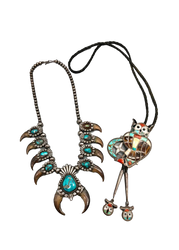The Changing Morality of Collecting
Posted by Jim Olson on Aug 7th 2023
The banning of items such as ivory, tortoise shell, bear claws, and certain other animal parts in the jewelry and decorative items industries has had great impact on the markets. These commonly used materials were once highly sought-after for their beauty, durability and unique aesthetic qualities. However, governments worldwide have implemented strict laws to prohibit certain trade. The bans have resulted in a decline in availability, increased enforcement efforts and changes in consumer preferences and market dynamics.
The Ban of Tortoise Shell
Tortoise shell was widely used in fashion and personal accessories, including hair combs and brushes, eyewear, jewelry, decorative objects and musical instruments. The ban, effective since 1973, compelled designers and manufacturers to either find alternative materials or cease production of certain items. Although trading in certain items made prior to the ban was initially allowed and widely accepted, it has become illegal worldwide since 2014 (unless sold with proven documentation to be 100 years or older). Consequently, the market value for tortoise shell items that are older than 1973 but not yet 100 has virtually disappeared with many dealers refusing to touch them. The initial surge in value due to limited availability has since plummeted to basically nothing (except on the black market). There are currently thousands of these types of items out there with no where to go.
Ongoing Coral Restrictions
Coral, particularly Mediterranean coral, known for its vibrant colors and unique texture, was once very popular in jewelry making. However, most countries have highly restricted the harvesting of coral since the 1980s, with even stricter regulations going into effect in 2019. This ban on coral harvesting has also impacted the industry. Designers and jewelers have had to seek alternatives and the re-sale market has seen a surge in prices for vintage pieces featuring coral. Sound familiar? The same thing happened with tortoise shell in the 1970s. However, the future for coral remains uncertain, as some speculate there is a possibility that coral items may face broader trade restrictions, similar to the complete ban on tortoise shell and most ivory items.
Market Shifts and Consequences
Bans and restrictions on things like ivory, tortoise shell, bear claws (only in certain places right now), and coral have significantly affected the availability and demand for items made from these materials. Tightening legal restrictions and international trade regulations have made it increasingly challenging to obtain the materials for commercial purposes. Consequently, prices for existing items have fluctuated, with some experiencing a surge in value initially, sometimes followed by a decline as demand diminished upon the trade being completely outlawed (such as tortoise shell and most ivory items).
Jewelry designers and retailers trying to keep up with the laws and trends have adapted their practices to comply with regulations and cater to changing consumer preferences. In many cases they have sought alternative materials. This has led to the emergence of new techniques and materials such as synthetic substitutes and recycled materials (which do not have the same collector’s market desirability as the original pieces).
Furthermore, governmental enforcement efforts against the illegal trade of banned materials has increased, driven largely by self-appointed watchdog organizations. But public perception has also changed. Recently on a Facebook post we observed, somebody had posted a piece of jewelry with bear claws. They were jumped all over by an un-educated public who were adamant that it was illegal to sell the piece. While in certain states, that may be true, but that is not the case everywhere. However, the general perception was that it is illegal, not only illegal, but according to some — immoral. There were several threatening to turn the poster in and the online cancel culture mob mentality was prevalent.
Where Do We Go From Here?
The outlawing of ivory, tortoise shell, bear claws in many places and coral restrictions has had far-reaching effects. The bans have reshaped the industry, leading to scarcity, price fluctuations and changes in consumer behavior. Designers and manufacturers try and adapt to meet the demands, but sometimes that is a moving target. While some vintage pieces with these banned materials experienced a temporary surge in value, who knows what the long-term market outlook could be. For example, vintage bear claw and coral jewelry (which are still legal to sell in most markets right now) do very well in those markets, but so did ivory and tortoise shell at one time (before facing even further restrictions). Will claws and coral go the way of ivory and tortoise shell? A better question might be, “What is next?” What material do we widely use right now that nobody thinks anything about which may be completely illegal to trade in 50 years from now?

